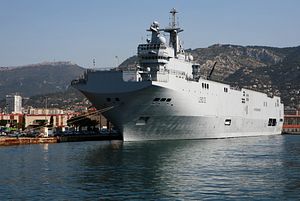Over the next two years, the Russian Pacific Fleet is expected to receive two new Mistral class amphibious assault ships, fresh from French naval yards. These flattops would have joined the burgeoning family of flat-decked aircraft carrying ships in the Pacific, including the Liaoning, the Korean Dokdos, the Australian Canberras, and the Japanese Izumo class.
That sale is now in considerable doubt. Because of Russia’s invasion and presumed annexation of Crimea, the European Union is considering a variety of sanctions against Moscow. The biggest stick, in military terms, may be the Mistrals, a pair of 21,000 ton warships capable of carrying over a dozen helicopters, in addition to a well-deck for amphibious landing craft. That the Russians chose to name the second ship Sevastopol, after a city not in Russian possession until after the recent invasion, only makes the sale so much uglier from the European point of view.
The ships were intended to fulfill a gap in the Pacific that has existed since the collapse of the Soviet Union, when the Soviet Pacific Fleet operated a pair of Kiev class carriers. Their amphibious capabilities made them particularly valuable as political chess pieces in the Pacific, as they could have operated in humanitarian and disaster relief operations under a variety of circumstances, and could have demonstrated Russian commitment far from Russian ports.
The purchase of the Mistrals (which was to include a pair of ships built under license in Russian yards) was controversial in Russia, given that it represented a transfer of scarce defense monies to a major foreign contractor. Some Russian analysts also expressed concern about what technologies the ships would include. However, given the inability of Russian yards to turn out large, quality ships since the end of the Cold War, the Mistrals represented the best chance of adding aviation and amphibious capabilities to Russia’s decaying fleets.
The French faced opposite concerns. While the ships represented a major boon to the French shipbuilding industry, and to French shipworkers, several NATO allies expressed worry that Russia might eventually use the ships against NATO or against a NATO associated state. The Libyan War, in which attack helicopters flew off French operated Mistrals, only added to these concerns.
Paris will face considerable pressure over the next six months regarding whether to formally transfer Vladivostok and Sevastopol to Russian control. Failing to turn over the ships could badly damage Franco-Russian relations, while going through with the sale will create problems for France’s NATO allies. Paris could seek a third party buyer; the Brazilian Navy could use a ship of the Mistral’s capabilities, although such a deal would face considerable obstacles. There’s no question, however, that France and Russia have dealt themselves into trouble.

































